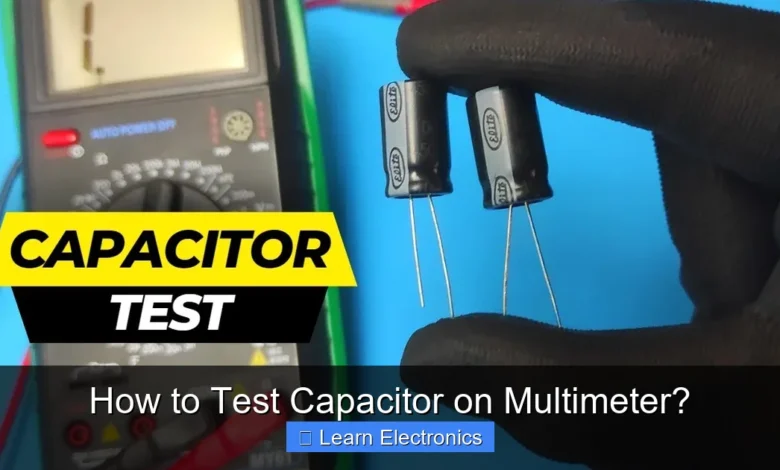How to Test Capacitor on Multimeter?

How to Test Capacitor on Multimeter? involves selecting the appropriate multimeter function – whether it’s capacitance, resistance, or diode check – and safely connecting the component. This technique is essential for diagnosing issues in electronic circuits by identifying faulty capacitors. Understanding the different approaches to testing these vital electronic components ensures accurate diagnostics and successful repairs, preventing further damage and restoring functionality.
Mastering this skill is fundamental for hobbyists and professionals alike, as capacitors are ubiquitous in nearly all electronic devices. With the right knowledge and a basic multimeter, you can confidently assess the health of these critical components.
Quick Answers to Common Questions
My multimeter has so many settings! Which one should I use to test a capacitor?
Great question! If your multimeter has a dedicated capacitance (or “uF”) setting, that’s your go-to for the most accurate results. Otherwise, for a quick check, you can use the resistance (Ohms) setting to observe it charging and discharging.
What kind of readings should I expect to see when I test a capacitor on a multimeter?
With the capacitance setting, you’ll want to see a value very close to the capacitor’s printed rating. If you’re using the resistance setting, a good capacitor will show a brief low resistance then steadily climb to infinity as it charges up!
Do I need to remove the capacitor from the circuit to test it on a multimeter?
For the most accurate results, absolutely! It’s always best practice to disconnect at least one lead of the capacitor from the circuit. This prevents other components from skewing your readings and gives you a true picture of the capacitor’s health.
📑 Table of Contents
Understanding Capacitors and Multimeters
Before diving into the testing process, it’s crucial to have a foundational understanding of what capacitors are and the types of multimeters available for testing them. This knowledge forms the bedrock of accurate diagnostics.
What is a Capacitor?
A capacitor is a passive two-terminal electrical component used to store electrical energy temporarily in an electric field. It essentially acts like a tiny, temporary battery, charging and discharging to smooth out voltage fluctuations, filter signals, or store energy for specific circuit operations. Capacitors come in various types, each suited for different applications:
- Electrolytic Capacitors: Often cylindrical, these have high capacitance values and are polarized, meaning they must be installed with correct polarity. They are common in power supply filtering.
- Ceramic Capacitors: Non-polarized, small, and stable, ideal for high-frequency applications and filtering.
- Film Capacitors: Offer good stability and precision, used in timing circuits and audio applications.
- Tantalum Capacitors: Similar to electrolytics but offer better performance in terms of stability and size, though they are more prone to failure if over-volted.
Each type behaves slightly differently under test conditions, but the core principle of storing and releasing charge remains the same.
Types of Multimeters for Capacitor Testing
The type of multimeter you use will dictate the accuracy and ease of your capacitor testing. Most modern digital multimeters (DMMs) offer a dedicated capacitance testing function, which is the most straightforward and accurate method.
- Digital Multimeters (DMMs) with Capacitance Function: These multimeters have a specific setting (often marked with a capacitor symbol, like
-||-) that directly measures capacitance in farads (F), microfarads (µF), nanofarads (nF), or picofarads (pF). They are the preferred tool for precise capacitor measurements. - Digital Multimeters (DMMs) without Capacitance Function: If your DMM lacks a dedicated capacitance mode, you can still test capacitors by using the resistance (ohm) function or the diode test function. These methods are less precise for determining exact capacitance but can effectively identify if a capacitor is shorted, open, or leaking.
- Analog Multimeters: While less common today, analog multimeters can also be used to test capacitors using their resistance function, observing the needle’s sweep for charge/discharge indication. This method requires some experience to interpret correctly.
Safety First: Before You Begin
Working with electronic components, especially capacitors, requires strict adherence to safety protocols. Capacitors, particularly larger ones, can store significant electrical charges even after power is disconnected, posing a shock hazard. Always prioritize safety to prevent injury or damage to your equipment.
Discharging Capacitors Safely
This is arguably the most critical step before handling any capacitor. A charged capacitor can deliver a dangerous shock or damage your multimeter. For smaller capacitors (e.g., those found on circuit boards with low voltage), the charge dissipates quickly. However, larger capacitors, especially in power supplies, can hold a lethal charge for extended periods.
To safely discharge a capacitor:
- Disconnect Power: Ensure the circuit is completely de-energized and unplugged from any power source.
- Use a Resistor: A safe way to discharge a capacitor is by using a power resistor (e.g., 2W, 1kΩ to 10kΩ). Connect one lead of the resistor to one terminal of the capacitor and the other lead to the other terminal. The resistor will safely dissipate the stored energy as heat. Larger capacitors may take several seconds or even minutes to fully discharge.
- Avoid Shorting with a Screwdriver: Never short capacitor terminals directly with a screwdriver or any metallic object. This can create a large spark, damage the capacitor, and potentially injure you.
- Verify Discharge: After discharging, use your multimeter on its DC voltage setting to confirm that the capacitor is fully discharged (reads near 0V).
Personal Protective Equipment (PPE)
While testing, wearing appropriate PPE is always a good practice:
- Safety Glasses: Protect your eyes from potential sparks or exploding components (though rare, it can happen with severely faulty capacitors).
- Insulated Gloves: Especially when working with higher voltage capacitors, insulated gloves provide an extra layer of protection against electric shock.
Power Disconnection
Always ensure the circuit containing the capacitor is completely disconnected from its power source. Do not attempt to test a capacitor while it is still in an energized circuit, as this can give inaccurate readings, damage your multimeter, or pose a severe safety risk.
The Primary Method: Using a Multimeter’s Capacitance Function
When your multimeter offers a dedicated capacitance measurement function, this is the most accurate and preferred way to assess a capacitor’s health. This approach directly measures the component’s capacitance and compares it against its marked value.
Setting Up Your Multimeter
- Turn off Power: Ensure the circuit containing the capacitor is completely de-energized and the capacitor is safely discharged.
- Remove Capacitor (Recommended): For the most accurate reading, it’s best to desolder and remove the capacitor from the circuit. In-circuit testing can sometimes yield misleading results due to parallel components.
- Select Capacitance Mode: Turn your multimeter’s dial to the capacitance function (often indicated by a capacitor symbol
-||-). - Select Range (if applicable): Some older multimeters might require you to manually select a capacitance range (e.g., nF, µF). Start with a range higher than the capacitor’s marked value and adjust downwards if necessary for a more precise reading. Auto-ranging multimeters will typically do this automatically.
- Insert Probes: Plug the red test lead into the VΩmA jack and the black test lead into the COM jack.
- Zero the Meter (if applicable): Some multimeters have a “relative” or “zero” button to null out the capacitance of the test leads themselves, providing a more accurate reading for very small capacitors.
Connecting the Capacitor
- Identify Polarity: For polarized capacitors (electrolytic, tantalum), observe the polarity. The longer lead is usually positive (+), and the stripe or shorter lead indicates negative (-).
- Connect Probes:
- For polarized capacitors: Connect the red (positive) test lead to the positive (+) terminal of the capacitor and the black (negative) test lead to the negative (-) terminal.
- For non-polarized capacitors: The connection order does not matter.
- Hold Steady: Ensure a firm, steady connection between the probes and the capacitor leads.
Interpreting the Reading
Once connected, the multimeter will display a capacitance value. Compare this reading to the value printed on the capacitor itself. Most capacitors have a tolerance, typically ±5%, ±10%, or ±20%. For example, a 100µF capacitor with a ±20% tolerance should read between 80µF and 120µF.
- Good Capacitor: The reading is close to the marked value, within its specified tolerance.
- Open Capacitor: The multimeter displays “OL” (Over Load), “1”, or no reading at all, indicating an open circuit. The capacitor cannot hold a charge.
- Shorted Capacitor: The multimeter displays a very low value, or sometimes even 0 F, indicating an internal short circuit.
- Leaky Capacitor: This is harder to detect with a simple capacitance test. A leaky capacitor might show a value close to its nominal rating but still perform poorly in a circuit. Other tests are better for this.
Alternative Methods: Resistance and Diode Check
If your multimeter doesn’t have a dedicated capacitance function, you can still perform basic tests using the resistance (ohms) or diode check functions. These methods are less precise but can help identify major faults like shorts or opens.
Testing with Resistance (Ohm) Function
This method works best for larger electrolytic capacitors (generally 1µF or higher) by observing their charging and discharging behavior. It’s less effective for smaller capacitors.
- Discharge Capacitor: Always discharge the capacitor safely first.
- Remove from Circuit: Desolder the capacitor from the circuit for accurate results.
- Set Multimeter to Ohms: Turn the dial to the resistance (Ω) setting. Start with a high range (e.g., 10kΩ or 100kΩ).
- Connect Probes:
- For polarized capacitors: Connect the red probe to the positive terminal and the black probe to the negative terminal.
- For non-polarized capacitors: Connect in any direction.
- Observe Reading:
- Good Capacitor: The multimeter will initially show a low resistance value (as it charges from the meter’s internal battery), and then the reading will slowly increase, moving towards “OL” (overload or infinite resistance) as the capacitor charges. The larger the capacitor, the slower this increase will be. Reverse the probes, and the process should repeat, with the resistance briefly dropping then climbing again as it charges in the opposite direction.
- Shorted Capacitor: The multimeter will continuously show a very low resistance (near 0Ω) or beep if it has a continuity function, indicating a direct short inside.
- Open Capacitor: The multimeter will immediately show “OL” or infinite resistance, indicating no charge path.
- Leaky Capacitor: The resistance will increase but not reach “OL”; it will settle at a specific, lower resistance value, indicating current is still flowing through it (a leak).
Using the Diode Test Function
The diode test function is primarily used to check semiconductors, but it can provide a quick, rough check for smaller capacitors, especially for identifying shorts.
- Discharge Capacitor: Safely discharge the capacitor.
- Remove from Circuit: Remove the capacitor for best results.
- Set Multimeter to Diode Test: Turn the dial to the diode symbol (often a diode with an arrow).
- Connect Probes:
- For polarized capacitors: Connect the red probe to the positive (+) terminal and the black probe to the negative (-) terminal.
- For non-polarized capacitors: Connect in any direction.
- Observe Reading:
- Good Capacitor: The multimeter will display a momentary voltage drop reading (e.g., 0.X V) and then settle to “OL” or “1” as the capacitor charges. Reversing the leads should repeat this behavior.
- Shorted Capacitor: The multimeter will show a constant low voltage reading (close to 0V) or beep continuously, indicating a short.
- Open Capacitor: The multimeter will immediately show “OL” or “1” and not change, indicating an open circuit.
Limitations of Alternative Methods
While useful, the resistance and diode check methods have limitations:
- They don’t provide an exact capacitance value.
- They are less effective for very small capacitors (pF to low nF range) as they charge too quickly for the multimeter to display a meaningful change.
- Identifying leaky capacitors can be ambiguous, as a very high leakage might look like an open circuit on a basic resistance test.
Common Capacitor Faults and Troubleshooting Tips
Understanding the common failure modes of capacitors helps in accurately diagnosing issues within circuits. Visual inspection often complements multimeter testing.
Open Capacitors
An “open” capacitor acts like a break in the circuit, preventing current flow or proper signal coupling. On a multimeter with a capacitance function, it will read “OL” or an equivalent no-reading error. With resistance or diode test, it will immediately show “OL” without any initial charge indication.
Shorted Capacitors
A shorted capacitor creates a direct path for current, bypassing its intended function. This can cause components to overheat, fuses to blow, or power supplies to fail. A multimeter in capacitance mode will read 0 F or a very low value. In resistance mode, it will show continuous low resistance (near 0Ω). The diode test will also show a continuous low voltage reading or beep.
Leaky Capacitors
A leaky capacitor allows some DC current to pass through its dielectric, reducing its effectiveness and potentially causing incorrect biasing or heating. This is often harder to detect. On a capacitance meter, it might still read close to its nominal value. With a resistance test, the reading will increase but settle at a finite resistance well below “OL”, rather than continuing towards infinite resistance. Advanced meters sometimes have an ESR (Equivalent Series Resistance) function, which is excellent for detecting leaky capacitors, especially electrolytics.
Visual Inspection
Always start troubleshooting with a visual check. Many faulty capacitors show tell-tale signs:
- Bulging Top: Especially common with electrolytic capacitors, a bulging or domed top indicates internal pressure buildup due to electrolyte degradation.
- Leaking Electrolyte: Brownish or crusty residue around the capacitor’s base often signifies electrolyte leakage.
- Discoloration/Burn Marks: Any signs of overheating on the capacitor body or the PCB around it could indicate a failure.
- Vent Opened: Some capacitors have vents on top that open to release pressure; if open, the capacitor has failed.
Typical Capacitor Characteristics & Expected Readings
This table provides a general guideline for interpreting multimeter readings for various capacitor types and conditions. Remember that precise values depend on the specific capacitor and multimeter used.
| Capacitor Condition | Capacitance Function (DMM) | Resistance Function (DMM/Analog) | Diode Test Function (DMM) | Visual Inspection |
|---|---|---|---|---|
| Good (Electrolytic) | Reads near nominal value (within tolerance). | Starts low, gradually increases to “OL”. Reverses for opposite polarity. | Momentary voltage drop, then “OL”. Reverses for opposite polarity. | Normal appearance, no bulging or leaks. |
| Good (Non-Polarized) | Reads near nominal value (within tolerance). | Starts low, gradually increases to “OL”. | Momentary voltage drop, then “OL”. | Normal appearance. |
| Shorted | 0 F or very low value. | Continuous low resistance (near 0Ω). | Continuous low voltage or beep. | Often normal, sometimes burnt/discolored. |
| Open | “OL”, “1”, or no reading. | Immediate “OL” (infinite resistance). | Immediate “OL” or “1”. | Often normal, sometimes bulging. |
| Leaky (Electrolytic) | May read near nominal value. | Increases then settles at a fixed, lower resistance (not “OL”). | Momentary voltage drop, then settles at a higher voltage than normal (not “OL”). | Often bulging or showing signs of electrolyte leakage. |
Conclusion
Testing capacitors with a multimeter is an invaluable skill for anyone involved in electronics repair or design. By understanding the functions of your multimeter and the behavior of different capacitor types, you can accurately diagnose faults and ensure the reliability of electronic circuits. Always prioritize safety by properly discharging capacitors and using appropriate protective gear before beginning any test. Whether you’re using a dedicated capacitance function or relying on resistance and diode checks, a methodical approach to this process will lead to successful troubleshooting and lasting repairs. Practice makes perfect, so don’t hesitate to test known good capacitors to familiarize yourself with their expected readings.
Frequently Asked Questions
How do I test a capacitor with a multimeter using the resistance setting?
To perform a basic functionality test, set your multimeter to the resistance (ohms) setting, typically in the kΩ or MΩ range. Connect the multimeter probes to the capacitor’s terminals, observing polarity if it’s an electrolytic capacitor. A healthy capacitor will show a momentary low resistance that gradually rises to infinity as it charges from the multimeter’s internal battery.
What is the best multimeter setting to accurately test a capacitor’s value?
For an accurate measurement of a capacitor’s value, the best setting is a dedicated capacitance (µF, nF, pF) function, if your multimeter has one. This setting will directly display the microfarad value, which you can compare to the capacitor’s stated rating. If your multimeter lacks this, you can still use the resistance setting to check for basic functionality, shorts, or opens.
What readings indicate a good versus a bad capacitor when using a multimeter?
When using the resistance setting, a good capacitor will show a brief low resistance reading that steadily climbs towards infinity (OL) as it charges. A bad capacitor might show zero resistance (shorted), immediate infinite resistance (open), or fail to charge properly. If using a dedicated capacitance setting, a good capacitor’s value should be close to its marked rating, typically within a 10-20% tolerance.
Can I use a multimeter to check if a capacitor is shorted or open?
Absolutely. To check for shorts or opens, set your multimeter to the resistance (ohms) setting. A shorted capacitor will show a constant near-zero resistance, while an open capacitor will immediately display infinite resistance (OL) and not change. Both of these readings signify a failed capacitor that requires replacement.



